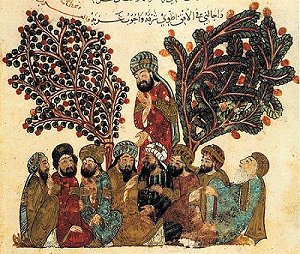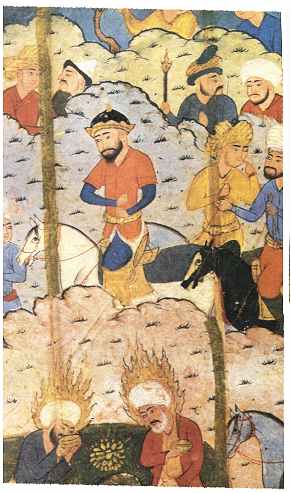Badi' al-Zaman al-Hamadani facts for kids
Badi' al-Zaman al-Hamadani (born 969, died 1007) was a famous Arab writer and scholar from Iran. His name means "The Wonder of the Age." He is best known for his book called Maqamat Badi' az-Zaman al-Hamadhani. This book is a collection of 52 short stories. They are about a clever trickster named Abu al-Fath al-Iskandari. The stories are told by a narrator named 'Isa b. Hisham.
Al-Hamadani's Life Story
We don't know much about Al-Hamadani's early life. Most of what we know comes from a Persian scholar named ath-Thalibi. Al-Hamadani was probably born and grew up in Hamadan, Iran.
We know more about Al-Hamadani's adult life. When he was 22, in the year 990, he left his hometown. He started traveling to different cities that were centers of learning. It was common for young, educated Arab men to travel like this.
His first stop was in Rayy. There, he met a supporter named Dihkhuda Abu Aid Muhammad ibn Mansur al-Isma. Next, he traveled to Jurjan. This is where he started writing his famous maqamat stories. People there really liked his writing.
In 992, he went to Nishapur in Khorasan. This city was a big center for literature. His time there was a mix of good and bad. He was robbed several times and lost all his belongings. But he also wrote many more stories. He became very famous in the region. He even had a disagreement with another writer, al-Khawrizmi.
After Nishapur was taken over by the Ghaznavids, he left and continued his travels. He stopped in places like Sarakhs, Tus, and Marw. Some old stories say he also visited Sijistan and Ghazna. But we don't have much proof of these visits.
In 993, he stopped in Zaranj. He was welcomed by the ruler, Abu Ahmad Khalaf ibn Ahdmad. Al-Hamadani wrote poems praising the ruler. He received good rewards for his writing.
What he did after Zaranj isn't very clear. He eventually settled in Bushanj, near Herat. He married into a noble family there and spent his last years. He wrote less during this time. He was protected by Abu'l-Hasan Isfaraini, who was an important advisor to Mahmud of Ghazni, the ruler of the Ghaznavid dynasty.
Al-Hamadani died in Herat when he was 40 years old. He was known for his amazing memory. He was also known for speaking very well and using pure, clear language.
Al-Hamadani's Writings
Al-Hamadani wrote poems, and many of his letters still exist today. He is seen as the person who started a special type of story called maqama (plural: maqamat).
A maqama is a short story that uses a special kind of rhyming prose called saj. Before Al-Hamadani, saj was mostly used for religious or political writings. But he used it to tell everyday stories. Other Arab writers later copied his style. About a hundred years later, another writer named Al-Hariri of Basra made the maqamat even more popular.
Al-Hamadani's Maqama stories often used funny tales that earlier writers had collected. But Al-Hamadani added a narrator to introduce these tales.
We still have 52 of Al-Hamadani's maqamat stories. Each maqama is a complete story on its own. But they are often put together in a collection with a main idea. Each story has two main characters:
- The narrator, usually named Isa ibn Hisham.
- A main character, usually Abu I-Fath of Alexandria, who is a clever trickster.
Other characters, sometimes real historical figures, appear in different stories. Al-Hamadani's maqamat stories were popular because they showed the lives of ordinary Arab people, including beggars and tricksters.
A maqama usually has seven parts:
- A short introduction.
- A general introduction to the story.
- A link to the main part.
- The main episode (the core of the story).
- A scene where characters recognize each other.
- A short ending message.
- The final part.
The maqama style uses Saj', which is a very fancy and detailed way of writing. Some parts of the story might be written in poetry. Other parts are written in regular, unrhymed prose. Al-Hamadani often borrowed poems from other famous poets for his stories.
See also
- Maqamat Badi' al-Zaman al-Hamadhani
- Arabic literature
- Arabic miniature



